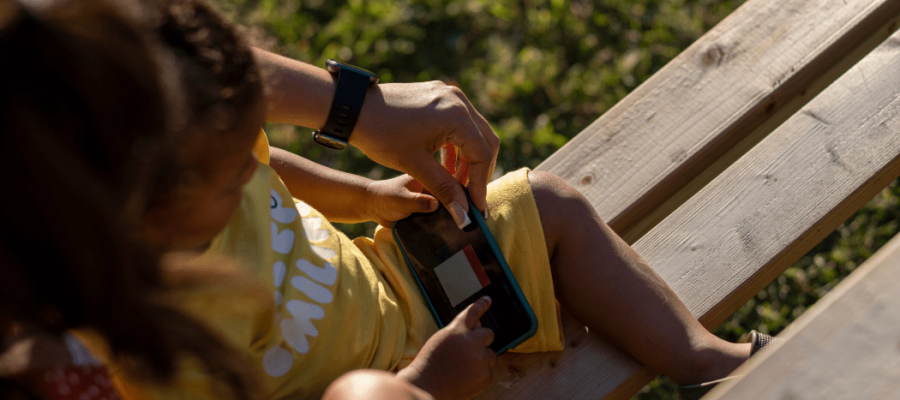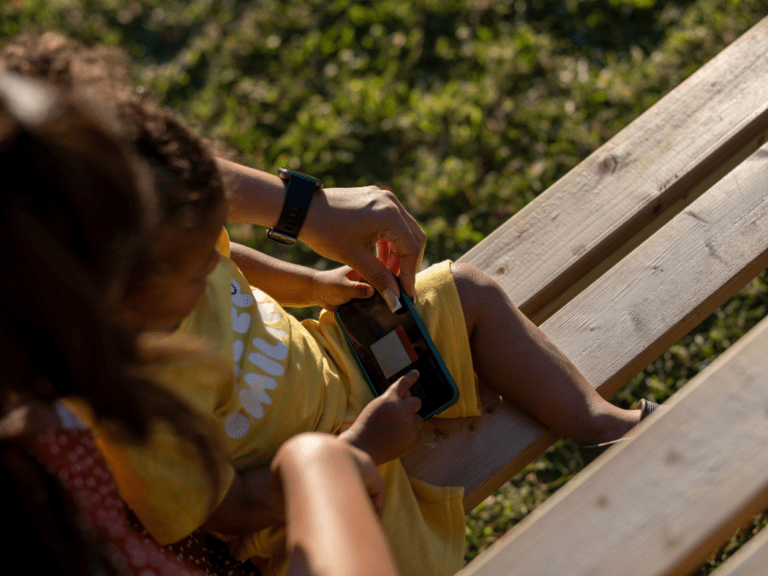Parental Controls Phone – How to Protect Your Child Online With Mobile Parental Controls
In this post, we explore the power of parental controls phone and how you take control of your child’s online safety and experience.
As you know, protecting our children online is a top priority for parents in today’s digital age! With the rise of mobile devices smartphones, laptops, iPads and all – it’s crucial to have effective parental controls on your child’s phone. So, let’s explore the benefits of using parental control apps on your child’s phone and how they can help you ensure their online safety.
Let’s dive in!
As parents/carers, we understand that the internet provides access to an incredible wealth of information and services, but some content may not be appropriate for children based on age, abilities, beliefs and family values.
Parental controls allow parents and carers to set and manage filters that block access to upsetting or inappropriate material that aligns with family values; they work across WiFi networks, phone networks and individual apps on devices.
Step 1: Parental Controls Phone – Setting up Parental Controls on Your Child’s Phone
Understand the Importance of Mobile Parental Control
Internet use has become a vital part of our children’s lives and is used for both socialising and learning purposes. But it may also expose them to harmful content like pornographic and sexual images, online bullying or predators or spending hours playing video games instead of studying or doing homework 🙂

Parental controls can help us parents and carers minimise risks by filtering upsetting or inappropriate content from across their internet connection, phone network, devices and apps.
Before setting parental controls on a device belonging to your child, it’s a good idea to discuss why you’re doing this with them, so they understand why being safe online is crucial.
Enable Built-in Parental Control Features
While the internet provides access to an abundance of knowledge, it also includes content that may be inappropriate for children. Sexting (text messaging and sending explicit photos), communicating with predators and communicating directly can all present risks that are unique to online environments that children must navigate safely.
Monitoring and restricting their screen time, apps they can use and web content can all help to keep your child safer online. Many mobile phone devices come equipped with built-in parental control features which you can use to keep an eye on what your child is up to online.
Apple iOS devices feature parental controls that enable you to set limits for in-app purchasing, social networking and other features. Furthermore, it’s a good idea to set wifi data limits and to disable mobile data on their phones. These will also help keep their phone batteries going for longer.
Step 2: Parental Controls Phone – Configure Content Filters
Configure content filters by installing third-party apps
There are lots of apps designed to help you monitor online content and restrict screen time on your child’s smartphones and tablets. Some apps come built into the phone while others can be got as add-on software or services from your mobile network providers.
Parental control software for mobile phones can block inappropriate content such as indecent images and videos from reaching children’s mobile phones. It can also filter social media and messaging apps, prevent sexting and monitor text messages.
Some apps even enable GPS tracking so you know where your child is at any given time. Our favorite is Qustodio which features numerous useful features with excellent support available through one-to-one help from staff members.
Understand though that filters cannot guarantee 100% protection, as older children quickly become adept users of technology and may figure out ways to bypass or disable these filters if needed.
Block Inappropriate Websites and Content
When choosing a parental control app, be sure to carefully read through its privacy policy and other details, such as how data collected will be used by its developer and whether any will be shared or sold to third parties.
Also, take into account your child’s age and personality when setting limits that are suitable. While your child may feel as if their privacy has been breached by you spying on them or violating their privacy rights, their safety should take priority over that concern.
Parental controls provide peace of mind while also giving you the ability to discuss and guide your kids’ online activity together, teaching them wise decision-making online. Furthermore, using parental controls may serve as a conversation starter that highlights there is no such thing as online privacy; thus it is up to us all to keep them safe until they reach an age where they can manage this themselves.
Step 3: Parental Controls Phone – Manage Screen Time and App Usage
Filter Social Media and Messaging Apps
Parental controls provide an invaluable service in protecting children online. By filtering upsetting or inappropriate words, images, and videos from websites to ensure a safer browsing experience for young users, parental controls offer protection.
Children and young people should be taught to think carefully before sharing personal information, including names, addresses, bank account numbers and phone numbers online. Sharing photos or videos could result in exploitation, bullying or cyberbullying of themselves or others.
Comprehensive internet security products provide children and young people with an extra layer of protection against cybercriminals operating within social media chatrooms and gaming websites, including chatrooms. Monitoring who they speak to or blocking specific contacts or keywords are especially useful for games and apps that offer end-to-end encryption, direct messaging, video chatting or user anonymity features.
Parental Controls Phone Secrets You Don’t Know – Video
Set Time Limits for Device Usage
Internet-enabled computers can provide kids with endless entertainment and educational resources; however, they also present risks such as inappropriate content, cyberbullying and online predators. While parental controls can help safeguard kids against these dangers, for optimal effectiveness they should be combined with an educational program on online safety.
Many broadband providers provide parental controls that filter adult content from devices connecting to home WiFi networks, making it inaccessible. Unfortunately, these filters don’t work when children disconnect or use mobile data, so it is wiser to discuss their use with your children so they understand why these controls exist and why you may set time limits or monitor locations to help build healthy digital habits in them.
Step 4: Parental Controls Phone – Monitor Your Child’s Online Activity
Control Access to Specific Apps and Games
The online world offers an immense wealth of information and services, some of which may not be appropriate for young children. These may include games, chat rooms and social media apps that enable them to engage in unsuitable interactions with strangers while sharing personal data that cybercriminals could misuse.
Kids can access pornography, illegal file-sharing programs and inappropriate websites through the browser on their computers or mobile phones. Furthermore, predators may approach them in gaming environments or on social media pages for social interaction – and send texts or photographs that could constitute sexting activity.
Comprehensive internet security software equipped with parental controls, virus protection and monitoring tools can help you protect your child as they explore the digital realm.
However, you also want to ensure these settings don’t hinder their individuality and independence in making informed choices for themselves when they come of age.
Track Web Browsing History
Children are exposed to technology from an early age and develop an affinity with it that often makes them unaware of potential dangers. From porn to sexting (sharing inappropriate text messages or photos) or chatroom predators, children can come into contact with harmful content that threatens their well-being.
They may download illegal file-sharing programs that provide access to music, movies and games. Furthermore, they might post personal details or photos online which predators could use to contact them directly; cyberbullying has become an increasing problem as a result.
Parental controls that monitor web browsing history can keep you aware of what your child is seeing online. Most internet service providers offer parental controls across their network devices and mobile apps that provide further monitoring ability.
Review Social Media and Text Messaging
An effective parental control program will assist in keeping an eye on what your children do online, blocking sites that contain inappropriate content or search terms as well as keeping tabs on correspondence with contacts online and text messages which contain personal data.
Even with parental controls in place, children still come across inappropriate content on the internet – this includes pornographic material such as images or websites as well as predators’ chatrooms and cyberbullying tactics.
Using parental control software that works across all devices – smartphones, tablets and computers – will provide your children with maximum protection online.
By setting device-level restrictions that remain in place no matter where your children access content online, parental controls provide maximum peace of mind for parents and guardians alike.
Step 5: Parental Controls Phone – Have Open Conversations About Online Safety
Teach Your Child About Internet Safety
Children need to understand that there are real risks online and learn to identify suspicious content such as pop-up advertisements and hyperlinks leading to potentially unsafe websites.
Early and frequent conversations about internet safety with your child will help them feel comfortable coming to you with any worries. And show that their safety is most important to you.

As with homework deadlines, agree upon digital rules as part of your family media plan.
Parental controls or monitoring software may help set restrictions on screen time or access to content, but their effectiveness will likely increase with an educational approach to their use.
Foster Open Communication and Trust
Communicate clearly with your child regarding what to expect online so they understand why parental controls are needed – not as an excuse for spying or monitoring their activities without their knowledge; rather, as a means to teach responsible digital citizenship skills.
Skills which you show, yourself, by being a positive digital role model, opening communication lines, and using transparent monitoring methods.
As a loving parent, of course you want to ensure your children understand that the Internet isn’t private. That their digital footprint will follow them around. And that they only post images and videos they are comfortable sharing publicly.
You also want to explain that one’s reputation can easily be destroyed online, and how important it is not to take advantage of another person online – or offline. Teaching your child about social media privacy settings, so they are accountable for managing their own accounts, would be useful as well.
Furthermore, consider teaching them how to recognise phishing emails or spam texts which could result in premium charges, account hacking or even personal details being sold on the dark web.
Conclusion – Ensuring Your Child’s Safety with Mobile Parental Controls
Many devices come equipped with built-in parental controls that are simple to use. On an iPad for instance, for instance, settings allow users to set screen time limits or filter out specific categories like mature movies and TV shows from access.
Most popular video games now come fitted with parental controls that enable you to limit how long your child plays every day. This can help you improve their sleep or school performance, or limit device time if it keeps being kept under their pillow at night.
Finally, you may use parental control apps to restrict where your child’s phone can be located, prevent apps from downloading, block all calls and texts, as well as enable YouTube’s safe search function. These filter explicit results such as pornography, so your child can find information more safely.











